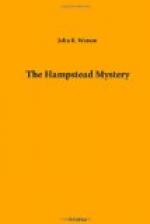CHAPTER XVIII
The second day of the trial began promptly when Mr. Justice Hodson took his seat. Mr. Holymead’s opening statement to the jury was brief. He reminded them that the life of a fellow creature rested on their verdict. If there was any doubt in their minds whether the prisoner had fired the shot which killed Sir Horace Fewbanks the prisoner was entitled to a verdict of “not guilty.” It was obligatory on the prosecution to prove guilt beyond all reasonable doubt.
He submitted that the prosecution had not established their case. After hearing the case for the prosecution the jury must have grave doubts as to the guilt of the prisoner, and it was his duty as Counsel for the prisoner to put before the jury facts which would not only increase their doubts but bring them to the positive conclusion that the prisoner was not guilty. He was not going to attempt to deny that the prisoner went to Riversbrook on the night of the murder. He went there to commit a burglary. But so far from Hill being terrorised into complicity in that crime it was he who had first suggested it to Birchill and had arranged it. Material evidence on that point would be submitted to the jury.
Hill was a man who was incapable of gratitude. His disposition was to bite the hand that fed him. After being well treated by Sir Horace Fewbanks he had made up his mind to rob him as he had robbed his former master Lord Melhurst. He knew that Sir Horace had quarrelled with this girl Fanning because of her association with Birchill, and he went to Birchill and put before him a proposal to rob Riversbrook. Birchill consented to the plan, and when on the night of the 18th August he broke into the house he found the murdered body of Sir Horace in the library. That was the full extent of the prisoner’s connection with the crime. To the superficial and suspicious mind it might seem an improbable story, but to an earnest mind it was a story that carried conviction because of its simple straightforwardness—its crudity, if the jury liked to call it that. It lacked the subtlety and the finish of a concocted story. The murder took place before Birchill reached Riversbrook on his burglarious errand.
“It is my place,” added Mr. Holymead, in concluding his address, “to convince you that my client is not guilty, or, in other words, to convince you that the murder was committed before he reached the house. It is only with the greatest reluctance that I take upon myself the responsibility of pointing an accusing finger at another man. In crimes of this kind you cannot expect to get anything but circumstantial evidence. But there are degrees of circumstantial evidence, and my duty to my client lays upon me the obligation of pointing out to you that there is one person against whom the existing circumstantial evidence is stronger than it is against my client.”
Crewe, who had secured his former place in the gallery of the court, looked down on the speaker. He had carefully followed every word of Holymead’s address, but the concluding portion almost electrified him. He flattered himself that he was the only person in court who understood the full significance of the sonorous sentences with which the famous K.C. concluded his address to the jury.




